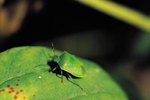
If you don't think something can be slimy and cute at the same time, then you've never met a newt. They account for around 70 of the roughly 350 known salamander species. While the dozens of known newt species have similar life cycles, some notable variations exist.
Egg
Newt eggs are encased in a gel-like substance rather than a hard shell. Adult females release eggs one at a time and store them in clusters ranging from a handful to several dozen in size. Adults often take an active role in defending their eggs after depositing them. Mothers may curl their body around the eggs to provide protection. Some newt species even wrap leaves around each egg individually to camouflage them, according to San Diego Zoo. Newt eggs are small: some measure only a millimeter or two in diameter. Mom usually anchors her eggs to underwater plants and other structures to keep them safe.
Tadpole
Newts that hatch from submerged eggs usually emerge as aquatic larvae with fishlike tails and gills that allow them to breathe beneath the water's surface. Not all newt species have an aquatic or "tadpole" phase. This stage tends to be short, except in fully aquatic species. Eastern newt (Notophthalmus viridescens) larvae spend only a few months as tadpoles, but they remain in the terrestrial larval stage for years before fully maturing, according to Island Creek Elementary School. Some newts spend their entire juvenile life as tadpoles and never go through a terrestrial stage.
Eft
Many newts progress to a terrestrial larval stage following their brief time as a tadpole. They are called "efts" at this point in their life cycle. Even newts that are aquatic as eggs and adults may spend several years on land as an eft between the two stages. The land-bound juveniles are still amphibious, so they require environments with shade and moisture. They tend to hide under stones, logs, fallen leaves and other forms of natural shelter in environments with damp soil, according to the New Hampshire Fish and Game Department.
Adult
Adult newts are versatile. Most have both legs and wide tails, so they can walk on land or swim in the water. However, individual species show a propensity for either terrestrial or aquatic environments and spend most of their time in one of them. The smooth newt (Lissotriton vulgaris) spends most of its adult life on land, but courtship and mating occur exclusively in aquatic environments during the appropriate season, according to the Online Field Guide. The reverse is true for other newt species, including the Eastern newt.
References
Photo Credits
-
Jupiterimages/Creatas/Getty Images
Writer Bio
Quentin Coleman has written for various publications, including All Pet News and Safe to Work Australia. He spent more tan 10 years nursing kittens, treating sick animals and domesticating semi-feral cats for a local animal shelter. He graduated from the University of Delaware with a bachelor's degree in journalism.




